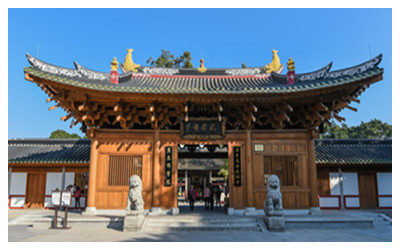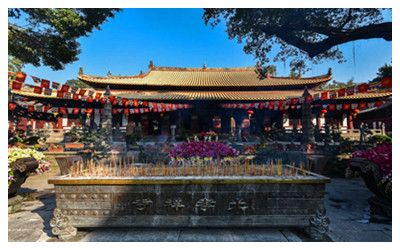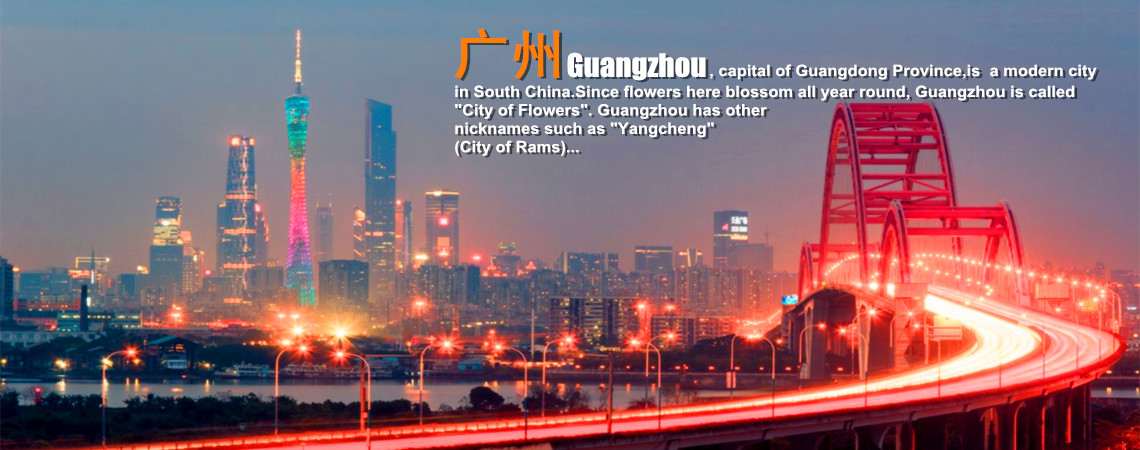Guangxiao Temple,also known as Bright Filial Piety Temple or Guangxiaosi, is among the grandest and most influential temples in China with a history dating back more than 1,700 years. The temple is said that 'The Guangxiao Temple existed before the birth of Guangzhou City'. In 1961, it was designated by the State Council as a Key National Cultural Preservation Site.
 History of teh Guangxiao Temple
History of teh Guangxiao Temple
Initially built during the Western Han Dynasty (207 BC - 24 AD) as a private house, Guangxiao Temple was used as a lecture hall before being dedicated completely to the function of a Zen Buddhist Temple during the Southern Song Dynasty (1127 - 1279). The many noted monks and sutra-translators who have resided there have contributed greatly to the spread of Buddhist culture. The pride of the temple is
Hui Neng, the famous sixth master of Zen Buddhism, who had his hair cut and was initiated into monkhood there.
What to see?
The architecture of the Guangxiao Temple and cultural relics provide insight into the history of Chinese Buddhism, culture, and architecture as well as the local history of Guangdong Province. The main complex consists of Mahavira Hall, Sixth Ancestor Hall (Liuzudian), Samgharama Hall, Heavenly King Hall (Tianwangdian), the East and West Iron Towers, and the Mahakaruna Dharani Sutra Pillar.
The Mahavira Hall

It was built in 401 during the Eastern Jin Dynasty (317 - 420) with additions made during succeeding dynasties. Today it is 35.36 meters long by 24.8 meters (81.36 feet) wide by 13.6 meters high. Situated on a high platform, the stately building, which is considered the most magnificent in South China, is guarded by the Bell Tower and the Drum Tower. Inside are three fine statues of Buddha. Travelers to other parts of South China will note that many other temples in the area have imitated the architectural style of Mahavira Hall.
The East and West Iron Towers
The East and West Iron Towers in Guangxiao Temple are the oldest iron towers in China. The West Iron Tower, the older of the two, was erected in 963; the East Tower was built four years later in 967. The four upper floors of the West Tower failed to survive the collapse of the house. The East Tower, which remains intact, is seven stories tall. About 1,000 shrines, each housing a small, exquisite statue of Buddha, are carved into the exterior of the tower. It is said that at the time of its completion, the exterior of the tower was gilded.
Sixth Ancestor Hall
The Sixth Ancestor Hall, located behind Samgharama Hall, was established during the Northern Song Dynasty (960 - 1127) in honor of Master
Hui Neng, a larger-than-life statue of whom is found inside. Behind this hall grows a bodhi tree, which symbolizes the Buddhist ideal of wisdom. In 676, the abbot of the temple buried Hui Neng's cut hair under the tree. Today the seven-story (7.8 meters) octagonal Yifa Pagoda stands as a memorial to him. Each level houses eight shrines.
In addition to these structures, other beautiful buildings and relics can be seen on the Temple grounds. The Heavenly King Hall boasts the 380-year old Helin Stele, which was inscribed during the Ming Dynasty (1368 - 1644).The Spring of Washing Bowl was dug in 527 to provide clear spring water in which Bodhidhamma, the initiator of Chinese Zen Buddhism, could wash his bowl. And the unique mushroom-shaped dharani pillar, which was made of bluestone in 826, is engraved on all eight sides with the words of the Mahakaruna Dharani Sutra.
Travel Tips
Add: Guangxiao Road, Guangzhou City,China
Entrance Fee: CNY 10
Opening Hours: 08:00-18:00

 History of teh Guangxiao Temple
History of teh Guangxiao Temple It was built in 401 during the Eastern Jin Dynasty (317 - 420) with additions made during succeeding dynasties. Today it is 35.36 meters long by 24.8 meters (81.36 feet) wide by 13.6 meters high. Situated on a high platform, the stately building, which is considered the most magnificent in South China, is guarded by the Bell Tower and the Drum Tower. Inside are three fine statues of Buddha. Travelers to other parts of South China will note that many other temples in the area have imitated the architectural style of Mahavira Hall.
It was built in 401 during the Eastern Jin Dynasty (317 - 420) with additions made during succeeding dynasties. Today it is 35.36 meters long by 24.8 meters (81.36 feet) wide by 13.6 meters high. Situated on a high platform, the stately building, which is considered the most magnificent in South China, is guarded by the Bell Tower and the Drum Tower. Inside are three fine statues of Buddha. Travelers to other parts of South China will note that many other temples in the area have imitated the architectural style of Mahavira Hall. Ask Questions ?
Ask Questions ?